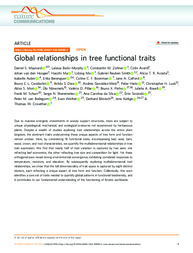Global relationships in tree functional traits.
Global relationships in tree functional traits.
Author(s): MAYNARD, D. S.; BIALIC-MURPHY, L.; ZOHNER, C. M.; AVERILL, C.; VAN DEN HOOGEN, J.; MA, H.; MO, L.; SMITH, G. R.; ACOSTA, A. T. R.; AUBIN, I.; BERENGUER, E.; BOONMAN, C. C. F.; CATFORD, J. A.; CERABOLINI, B. E. L.; DIAS, A. S.; GONZÁLEZ-MELO, A.; HIETZ, P.; LUSK, C. H.; MORI, A. S.; NIINEMETS, Ü.; PILLAR, V. D.; PINHO, B. X.; ROSELL, J. A.; SCHURR, F. M.; SHEREMETEV, S. N.; SILVA, A. C. da; SOSINSKI JUNIOR, E. E.; VAN BODEGOM, P. M.; WEIHER, E.; BÖNISCH, G.; KATTGE, J.; CROWTHER, T. W.
Summary: Due to massive energetic investments in woody support structures, trees are subject to unique physiological, mechanical, and ecological pressures not experienced by herbaceous plants. Despite a wealth of studies exploring trait relationships across the entire plant kingdom, the dominant traits underpinning these unique aspects of tree form and function remain unclear. Here, by considering 18 functional traits, encompassing leaf, seed, bark, wood, crown, and root characteristics, we quantify the multidimensional relationships in tree trait expression. We? nd that nearly half of trait variation is captured by two axes: one re? ecting leaf economics, the other re? ecting tree size and competition for light. Yet these orthogonal axes reveal strong environmental convergence, exhibiting correlated responses to temperature, moisture, and elevation. By subsequently exploring multidimensional trait relationships, we show that the full dimensionality of trait space is captured by eight distinct clusters, each re? ecting a unique aspect of tree form and function. Collectively, this work identi? es a core set of traits needed to quantify global patterns in functional biodiversity, and it contributes to our fundamental understanding of the functioning of forests worldwide.
Publication year: 2022
Types of publication: Journal article
Keywords: Biodiversidade, Floresta, Árvore
Observation
Some of Embrapa's publications are published as ePub files. To read them, use or download one of the following free software options to your computer or mobile device. Android: Google Play Books; IOS: iBooks; Windows and Linux: Calibre.
Access other publications
Access the Agricultural Research Database (BDPA) to consult Embrapa's full library collection and records.
Visit Embrapa Bookstore to purchase books and other publications sold by Embrapa.

